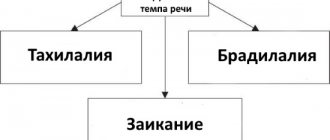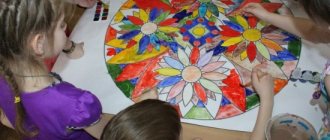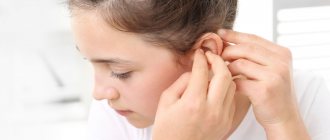Air jet formation
Category: Teacher-speech therapist Golubeva O.V. Published: 01/05/2014
The formation of an air stream in the process of overcoming sound pronunciation disorders is the main direction of speech therapy correction, without which it is impossible to achieve the desired result.
The main purpose of the breathing apparatus is to carry out gas exchange, that is, the delivery of oxygen to the body tissues and the removal of carbon dioxide from them. And this exchange occurs thanks to the periodic renewal of air in the lungs, which occurs during the alternating alternation of respiratory phases - inhalation and exhalation.
There are three main types of breathing:
- clavicular
- costal (thoracic)
- diaphragmatic (abdominal)
During clavicular breathing, the shoulder girdle and upper ribs rise, and predominantly the upper part of the chest expands.
With rib (chest) the chest expands forward and to the sides.
In diaphragmatic breathing - the diaphragm lowers and mainly the lower part of the chest increases; the abdominal wall protrudes.
Pure types of breathing are not actually observed. In any type of breathing, the diaphragm is active to a greater or lesser extent. Therefore, practically we can only talk about predominantly key, predominantly abdominal, or clavicular breathing.
Types of breathing depend on gender, age, profession.
Thus, in women the thoracic type of breathing is more often observed, in men - the abdominal type, in manual workers the abdominal type of breathing prevails, in persons engaged in clerical and generally sedentary work - the thoracic type.
Children usually have a mixed type of breathing, that is, an average between abdominal and thoracic.
With deep or full breathing, three types of breathing are combined - clavicular, thoracic, abdominal.
Within 1 minute, 16-20 complete respiratory movements (inhalations and exhalations) occur. The duration of inhalation is almost equal to the duration of exhalation (the ratio of inhalation time to exhalation time is approximately 1: 1.25).
This is physiological breathing necessary for life.
But in order for a child to start speaking, he must master a special type of breathing - speech breathing. This term refers to a person’s ability, in the process of speaking, to take a sufficiently deep breath in a timely manner and rationally expend air when exhaling. Speech breathing is the basis of sounding speech, the source of the formation of sounds and voices. It ensures normal voice production, helps to correctly observe pauses, maintain fluency of speech, change volume, and use speech melody.
The development of speech breathing in a child begins at the age of 6 months, with the preparation of the respiratory system for the implementation of vocal reactions, and is completed by the age of 10 years.
The formation of speech breathing involves, among other things, the production of an air stream. The production of an air stream is considered one of the necessary and significant conditions for producing sounds. Work on the education of an air stream begins at the preparatory stage of the formation of correct sound pronunciation, along with the development of phonemic hearing and articulatory motor skills.
It is known that sounds are pronounced during the exhalation phase. As a rule, stop plosives and stop - fricative consonants are pronounced briefly, the air stream is weak. Sonorant sounds and fricatives require a strong, long-lasting air stream.
The pronunciation of most sounds of late ontogenesis requires a directed air stream. Let's look at the example of the characteristics of an air stream necessary when pronouncing hissing and whistling sounds.
| Hissing | Whistling |
| Wide (when pronouncing hissing sounds) | Narrow (when making whistling sounds) |
| Warm (when making hissing sounds) | Cold (when making whistling sounds) |
| Weak | Strong |
| Absent-minded | Directed |
There are three main directions of air flow:
- the air stream is directed directly at the center of the tongue. This is typical for most sounds; labiolabial (V, V, F, F, posterior lingual (K, K. G, G. X, X, anterior lingual (T, T, D, D, sibilant (S, S, Z, Z, C))
- the air stream is directed upward along the center of the tongue. This is typical for the pronunciation of hissing sounds (Ш, Ж, ШЧ, Ш) and vibrants (Р, Р).
- the air stream is directed along the lateral edges of the tongue. This is typical for the pronunciation of stop-passive (L, L) sounds.
In accordance with the listed directions of passage of the air stream in the oral cavity, the following exercises are used in speech therapy work:
- “Blow the snowflakes off the slide.” (use pieces of cotton wool or foam balls) “Punish the naughty tongue.” "Groove".
- "Tricks".
- “A hunter is walking through the swamp”
The production of an air stream can be carried out before articulatory gymnastics or simultaneously with articulatory gymnastics. Since the cheeks, lips, and tongue take an active part in the formation of the air stream.
Articulation exercises performed while exhaling:
- "Turkey poults." As you exhale, pronounce “Bl-bl-bl.”
- “Punish the naughty tongue.” As you exhale, pronounce “Five-five-five.”
- “Machine gun” As you exhale, pronounce “T-t-t.”
- "Motor". As you exhale, pronounce “R-r-r.”
- “Bug” As you exhale, pronounce “Zh-zh-zh.”
In the system of speech therapy work on air flow education, the following main directions can be distinguished:
- Blowing with closed lips.
- Blowing through lips extended with a tube.
- Pouting through lips stretched into a smile.
- Blowing on the tongue.
Let's take a closer look at each direction.
- Blowing with closed lips. To strengthen the cheek muscles, the following exercises can be considered preparatory:
- “Blow up two balloons” Puff up your cheeks and hold the air in them.
- “Rolling the balls” The cheeks are inflated one by one.
- "Skinny ones." Retract your cheeks with your lips closed and your mouth slightly open.
- “Blowing through lips extended with a tube.” Tension of the orbicularis oris muscle.
- Blowing through lips extended with a tube.
- Without puffing out your cheeks, blow through your lips brought together and slightly pushed forward, forming a round “window” in the middle.
- Blow away any soft object (cotton ball, paper snowflake, etc.) from the palm of your hand raised to your mouth.
- Blow on a piece of cotton wool tied to threads. You can blow upward on the dandelion fluffs and try to keep them in the air longer.
- Blowing on a sailboat, napkin, sheet, weather vane, etc.
- Blow on a pencil lying on the table so that it rolls (on hexagons)
- Blowing out a candle.
- Inflating balloons and rubber toys.
- Blowing soap bubbles.
- Blowing using whistles. Horns, pipes, harmonica.
- Races on the water with paper boats and celluloid toys, for example, blowing up “fish”.
- Children are asked to take turns blowing on light toys placed in a basin of water.
- Blow hard on the water until it splashes.
- You can stretch the threads horizontally and tie light paper birds, butterflies, and dragonflies to the vertically hanging threads.
- Blowing is the rolling of light wooden or celluloid balls along a groove.
- Pouting through lips stretched into a smile.
- “Propeller” Form a narrow gap between the close lips stretched in a slight smile. The corners of the mouth are pressed against the teeth. The child cuts the stream of air directed into this gap by moving the index finger from side to side. If the gap is formed correctly and the jet is strong enough, the sound from the air cut by the finger is clearly audible.
- Form a narrow gap between the lips, stretched together in a slight smile. The child is asked to place the wide tip of his tongue between his lips. Blow on the tip of your tongue.
- Form a narrow gap between the lips, stretched together in a slight smile. “Slap” your tongue with your lips, making the sounds of five-five-five as you exhale.
- Blowing on the tongue.
- In the middle of the tongue along its front edge, “make a path” - put a match with a cut off head and blow off the paper leaves with a breeze.
- Holding your tongue wide behind your upper teeth, you need to blow on its tip. Instructions: “Smile. Show your teeth. Keep your tongue wide at the top. Can you feel the breeze? Blow like that again. Feel how I blow! »You can use a mirror so that the child can see the position of his tongue.
- Place your wide tongue on your lower lip. Fold the edges of the tongue so that a groove is formed. It's easy to blow through the groove.
- “Blow the snowflakes off the slide” Smile. Show your teeth. Open your mouth slightly. Hold the tip of your tongue behind your lower teeth. Lift your tongue up. Blow on your tongue.
In the process of corrective work on the formation of an air stream, it is important to adhere to the following methodological recommendations.
- Exercises are carried out in a well-ventilated area.
- It is better to perform the exercises while standing, with the body in a free position in space. The chest is straightened. Watch your posture.
- Attention is drawn to ensuring that the child inhales deeply and calmly through the nose. Exhalation through the mouth should be light, smooth, without tension.
- Monitor the accuracy of the direction of the air stream.
- The duration of the exercises (from 30 seconds to 1.5 minutes). Hyperventilation of the lungs leads to an abundant supply of oxygen to the cerebral cortex, which can result in dizziness.
- Dosage of quantity and pace of exercises. Intensive blowing should be carried out no more than 5 times at a time, for several seconds.
- You can't puff out your cheeks.
- Do not hold in the exhaled air. You can hold your cheeks with your hands to use tactile control.
- In the initial stages, you can use a mirror to attract visual control.
- Control of the exhaled stream of air is carried out using a cotton swab brought to the child’s mouth: if the exercise is performed correctly. The fleece will deviate.
- Exercises can be performed counting.
We wish you success!
Teacher-speech therapist Olga Viktorovna Golubeva MADOU “Kindergarten” p. Dog
www.Logopedy.ru
Author: Zakharova Yulia Alexandrovna
teacher-speech therapist MADOU "Kindergarten "141"
Aircraft construction district of Kazan.
Original: .
The formation of speech breathing involves, among other things, the production of an air stream. The production of an air stream is considered one of the necessary and significant conditions for producing sounds. Work on the education of an air stream begins at the preparatory stage of the formation of correct sound pronunciation, along with the development of phonemic hearing and articulatory motor skills
Parameters of correct oral exhalation:
- exhalation is preceded by a strong inhalation through the nose - “we take a full chest of air”; - exhalation occurs smoothly, slowly, evenly, and not in jerks; — during exhalation, the lips form a tube; you should not compress your lips;
- do not puff out your cheeks!!!; — during exhalation, air exits through the mouth; air should not be allowed to exit through the nose. - you should exhale until the air runs out;
Ask the child to blow through the lips extended in a tube - Without puffing out the cheeks, blow through the lips brought together and slightly pushed forward, forming a round “window” in the middle.
• Blow away any soft object (cotton ball, paper snowflake, etc.) from the palm of your hand brought to your mouth. Blow on pieces of cotton wool tied on a thread.
• Blow on a pencil lying on the table so that it rolls.
• Blowing soap bubbles.
• Blowing using whistles, horns, pipes, harmonica.
• Races on water with paper boats and celluloid toys, for example, blowing up “fish”. Children are asked to take turns blowing on light toys placed in a basin of water.
• Blow into the water through a straw to make the water in the glass “boil.”
When playing games aimed at developing a child's breathing, it is necessary to keep in mind that breathing exercises quickly tire the child and can even cause dizziness. Therefore, such games must be limited in time (you can use an hourglass) and be sure to alternate with other exercises.
The formation of speech breathing involves, among other things, the production of an air stream. The production of an air stream is considered one of the necessary and significant conditions for producing sounds. Work on the education of an air stream begins at the preparatory stage of the formation of correct sound pronunciation, along with the development of phonemic hearing and articulatory motor skills
Parameters of correct oral exhalation:
- exhalation is preceded by a strong inhalation through the nose - “we take a full chest of air”; - exhalation occurs smoothly, slowly, evenly, and not in jerks; — during exhalation, the lips form a tube; you should not compress your lips;
- do not puff out your cheeks!!!; — during exhalation, air exits through the mouth; air should not be allowed to exit through the nose. - you should exhale until the air runs out;
Ask the child to blow through the lips extended in a tube - Without puffing out the cheeks, blow through the lips brought together and slightly pushed forward, forming a round “window” in the middle.
• Blow away any soft object (cotton ball, paper snowflake, etc.) from the palm of your hand brought to your mouth. Blow on pieces of cotton wool tied on a thread.
• Blow on a pencil lying on the table so that it rolls.
• Blowing soap bubbles.
• Blowing using whistles, horns, pipes, harmonica.
• Races on water with paper boats and celluloid toys, for example, blowing up “fish”. Children are asked to take turns blowing on light toys placed in a basin of water.
• Blow into the water through a straw to make the water in the glass “boil.”
When playing games aimed at developing a child's breathing, it is necessary to keep in mind that breathing exercises quickly tire the child and can even cause dizziness. Therefore, such games must be limited in time (you can use an hourglass) and be sure to alternate with other exercises.
Social commentary Cackle
Compiled by: teacher - speech therapist MADOU TsRR - kindergarten No. 50 of the city of Tyumen T.V. Sinitskaya
An air stream is the energetic basis of a sound, syllable, word, phrase . Without a strong, long-lasting air stream, not only sound pronunciation is disrupted, but also the overall sound of speech: speaking “excitedly”, not pronouncing the endings of words, “blurring” the end of a phrase.
The development of speech breathing is one of the first and very important stages of corrective intervention for preschoolers with speech disorders. Speech breathing is the basis of sounding speech, the source of the formation of sounds and voices. Well-placed breathing ensures clear diction and precise pronunciation of sounds. The formation of speech breathing depends on the proper functioning of physiological breathing. It differs from speech in that in the process of speaking, after inhalation, which is most often carried out simultaneously through the mouth and nose, there is a pause, and then a smooth exhalation ( with physiological breathing, inhalation is immediately followed by an exhalation, and then a pause). Speech breathing is carried out voluntarily, non-speech breathing is carried out automatically. During speech breathing, the exhalation, depending on the content of the utterance, can be either shorter or longer; inhalation is carried out in one impulse, exhalation - in several and constantly changes in its strength. To teach a child to control his voice, he must be taught to breathe correctly: both functions are performed by the same organs. Correct breathing is a short, deep breath and a smooth, economical exhalation. This type of movement is difficult for children who have speech disorders. It is necessary to systematically work with them on the formation of speech breathing, starting with easy breathing exercises and moving on to more complex ones. Speech therapy practice shows that speech disorders in preschool children are becoming more and more complex. Normally, speech breathing is finally formed in children by the age of 10 voluntarily. Speech breathing in such children develops as their speech function develops. Physiological breathing of preschool children with speech disorders has its own characteristics: - shallow breathing, upper costal type; – the breathing rhythm is unstable, easily disrupted by physical and emotional stress; ‒ lung volume is significantly lower than the age norm.
Accordingly, speech breathing in such children develops pathologically. In the process of speaking, they experience the following: - holding their breath; - convulsive contractions of the muscles of the diaphragm and chest; - extra breaths. The process of forming speech breathing is carried out on the basis of an interdisciplinary approach, which allows us to comprehensively solve speech therapy, pedagogical, psychological, and medical issues, providing natural connections in the use of non-traditional methods. Ignoring at least one of them inevitably leads to a deficiency of others and a decrease in the quality of speech therapy work with children in general. A. R. Luria, N. M. Sechenov, I. A. Sikorsky distinguish three methods of breathing: - upper breathing (clavicular); - middle breathing (thoracic and costal, or intercostal); - lower breathing (abdominal, or deep, or diaphragmatic ). It has been established that the most correct and convenient for speech is diaphragmatic, or also called diaphragmatic-costal, breathing, when inhalation and exhalation are performed with the participation of the diaphragm and intercostal muscles. The lower, most capacious part of the lungs is active. The upper chest, as well as the shoulders, remain practically motionless. Each age has its own indicators of pronouncing a certain number of words while exhaling.
Age of the child The number of words on exhalation is normal. Duration of correctional activities for the formation of speech breathing 2–3 years 2–3 words 2–3 min. 3–4 years 3–5 words 3–4 min. 4–6 years 4–6 words 4–6 min. 6–7 years 5–7 words 5–7 min. Speech breathing in preschool children aged 5–7 years with speech disorders is characterized by: – small lung volume; - weak respiratory muscles; - weak inhalation and exhalation, which leads to quiet, barely audible speech (often observed in physically weak children, as well as timid, shy ones); - uneconomical and uneven distribution of exhaled air (as a result of this, a preschooler sometimes exhales the entire supply of air on the first syllable and then finishes the phrase or word in a whisper, often because of this he does not finish the end of the word or phrase); ‒ inept distribution of breathing according to words (the child inhales in the middle of a word (my mother and I sing - (inhale) - let’s go for a walk); ‒ hastily pronouncing phrases without interruption and while inhaling, with “choking; ‒ weak exhalation or an incorrectly directed exhaled air stream, which, in turn, leads to distortion of sounds.
Correctly formed speech breathing in preschoolers who need speech therapy help ensures rapid assimilation of sounds, can change the strength of their sound, helps to observe pauses, maintain fluency of speech, change volume, and use speech melody. A teacher-speech therapist, conducting correctional and developmental activities to form speech breathing in preschoolers 5–7 years old with speech disorders, works closely with parents and educators. Parents monitor and control their children's breathing . Recommendations for performing breathing exercises: - carry out breathing exercises in a well-ventilated room or with an open window; - carry out correctional and developmental activities before meals; - exercise in loose clothing that does not restrict movement; ‒ air must be taken through the nose, do not raise your shoulders; - exhalation should be long and smooth; ‒ it is necessary to ensure that your cheeks do not puff out (at the initial stage, you can press them with your palms); - during speech breathing, do not strain the muscles in the neck, arms, chest, and abdomen; ‒ breathing exercises can be performed both in a sitting and standing position; - three to five repetitions are enough. Repeated breathing exercises can lead to hyperventilation! The onset of hyperventilation can be determined by the following signs: - dose the amount and pace of exercise; after exhaling, pause for 2-3 seconds before inhaling again.
Work on the formation of correct speech breathing is carried out in the project in a certain sequence:
Stage 1 : formation of diaphragmatic breathing (exercise “Hold the toy.” Children, lying on the carpet, inhale deeply - the tummy inflates, then exhale - the tummy retracts).
Stage 2: teaching children the ability to differentiate inhalation and exhalation through the nose and mouth (according to the diagram), sitting, standing, hand on tummy.
Stage 3: we form a targeted air stream, produce a strong, smooth, extended exhalation. To develop the child’s breathing, breathing games are used: blowing snowflakes, pieces of paper, fluff from the table, from the hand; blow on light balls, pencils, candles, on ducks floating in a basin, on boats, on all kinds of turntables; inflate inflatable toys, balloons, blow soap bubbles; blow up some fluff or cotton wool.
Stage 4: development of such breathing qualities as strength, duration, gradualness and purposefulness. Regulation of respiratory rhythm. Start by singing vowel sounds: - On the exhale, one sound (a, y, o) - On the exhalation, two sounds (ay, ua) - Saying a word, a simple sentence on one exhalation (This is a doll. This is a dog.) - Gradually lengthen the phrase, adding new words. The development and education of speech breathing are closely related to the development and education of the voice. Many exercises for the development of speech breathing (for example, “Show how the locomotive hums”, “How the baby cries” and others also develop the voice.
Game exercises for voice development are carried out on onomatopoeias that are well known to children: the howl of a wolf - oo-oo-oo, the hooting in the forest - au-au-au. Performing breathing exercises in a playful way causes a positive emotional mood in the child, relieves stress and contributes to the formation of practical skills. While doing breathing exercises, a child will find himself in a special microworld of fairy tales, songs, games, and poems. Formation of correct speech breathing in children of senior preschool age allows:
Reduce time for production and automation of speech sounds
Increase the number of words spoken as you exhale.
Develop clear and intelligible speech. Achieve coordination of breathing, speech and movements.







